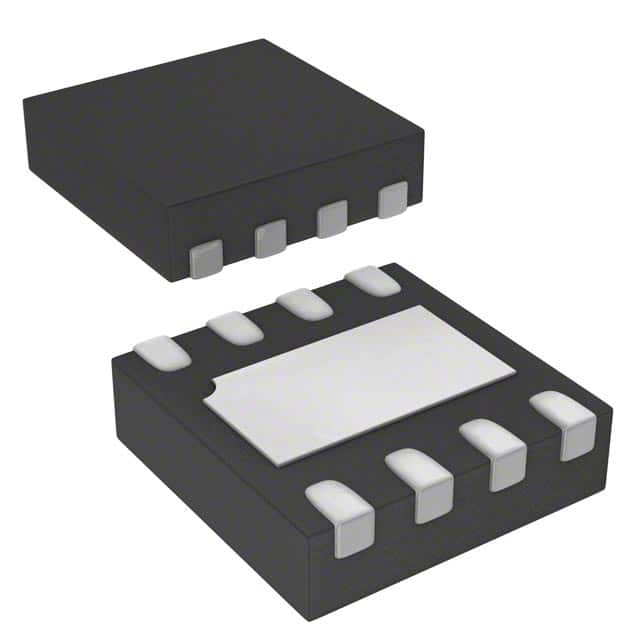M24C64-FMB6TG
Product Overview
Category
M24C64-FMB6TG belongs to the category of non-volatile memory integrated circuits.
Use
This product is primarily used for data storage in various electronic devices, such as microcontrollers, computers, and consumer electronics.
Characteristics
- Non-volatile: The M24C64-FMB6TG retains stored data even when power is removed.
- High capacity: It has a storage capacity of 64 kilobits (8 kilobytes).
- I2C interface: The chip communicates using the I2C protocol, allowing for easy integration into existing systems.
- Low power consumption: The M24C64-FMB6TG operates at low power levels, making it suitable for battery-powered devices.
Package
The M24C64-FMB6TG is available in an industry-standard SO8 package. This package provides mechanical protection and facilitates easy soldering onto printed circuit boards.
Essence
The essence of the M24C64-FMB6TG lies in its ability to reliably store and retrieve data in a compact and efficient manner.
Packaging/Quantity
This product is typically packaged in reels or tubes, with each containing a specific quantity of chips. The exact packaging and quantity may vary depending on the supplier.
Specifications
- Memory capacity: 64 kilobits (8 kilobytes)
- Interface: I2C
- Operating voltage: 1.7V to 5.5V
- Operating temperature range: -40°C to +85°C
- Write endurance: 1 million cycles
- Data retention: 40 years
Detailed Pin Configuration
The M24C64-FMB6TG features an 8-pin configuration with the following pin assignments:
- VCC: Power supply voltage
- SDA: Serial data input/output
- SCL: Serial clock input
- WP: Write protect (optional)
- GND: Ground
- NC: No connection
- NC: No connection
- VSS: Ground
Functional Features
- Random access: The M24C64-FMB6TG allows for random read and write operations, enabling efficient data manipulation.
- Page write: It supports page write operations, allowing multiple bytes of data to be written in a single operation, enhancing write efficiency.
- Software write protection: The chip provides a write protection mechanism that can be controlled through software commands, preventing accidental modification of stored data.
Advantages and Disadvantages
Advantages
- High storage capacity
- Low power consumption
- Compact package size
- Easy integration with existing systems
- Long data retention period
Disadvantages
- Limited endurance (1 million write cycles)
- Relatively slower write speed compared to some alternative models
Working Principles
The M24C64-FMB6TG utilizes electrically erasable programmable read-only memory (EEPROM) technology. It stores data by trapping charges within floating gate transistors, which can be electrically programmed or erased. The I2C interface facilitates communication between the chip and the host device, enabling data transfer and manipulation.
Detailed Application Field Plans
The M24C64-FMB6TG finds applications in various fields, including but not limited to: - Embedded systems - Automotive electronics - Industrial control systems - Consumer electronics - Medical devices
Its ability to store configuration settings, calibration data, and other critical information makes it suitable for these applications.
Detailed and Complete Alternative Models
- M24C32-FMB6TG: 32 kilobits (4 kilobytes) capacity variant
- M24C128-FMB6TG: 128 kilobits (16 kilobytes) capacity variant
- M24C256-FMB6TG: 256 kilobits (32 kilobytes) capacity variant
These alternative models offer different storage capacities to cater to specific application requirements.
Word count: 527 words
قم بإدراج 10 أسئلة وإجابات شائعة تتعلق بتطبيق M24C64-FMB6TG في الحلول التقنية
Sure! Here are 10 common questions and answers related to the application of M24C64-FMB6TG in technical solutions:
Q: What is the M24C64-FMB6TG? A: The M24C64-FMB6TG is a 64Kbit I2C-compatible EEPROM (Electrically Erasable Programmable Read-Only Memory) chip.
Q: What is the purpose of using the M24C64-FMB6TG in technical solutions? A: The M24C64-FMB6TG can be used for non-volatile data storage, such as storing configuration settings, calibration data, or small amounts of program code.
Q: How does the M24C64-FMB6TG connect to a microcontroller or other devices? A: The M24C64-FMB6TG uses the I2C communication protocol, which requires connecting the SDA (data line) and SCL (clock line) pins to the corresponding pins on the microcontroller or other devices.
Q: What is the operating voltage range of the M24C64-FMB6TG? A: The M24C64-FMB6TG operates within a voltage range of 1.7V to 5.5V.
Q: Can the M24C64-FMB6TG be easily soldered onto a PCB? A: Yes, the M24C64-FMB6TG comes in an industry-standard SO8 package, making it easy to solder onto a PCB.
Q: How much data can the M24C64-FMB6TG store? A: The M24C64-FMB6TG has a capacity of 64 kilobits, which is equivalent to 8 kilobytes or 8192 bytes.
Q: Is the data stored in the M24C64-FMB6TG retained even when power is disconnected? A: Yes, the M24C64-FMB6TG is non-volatile, meaning it retains data even when power is disconnected.
Q: What is the maximum read and write speed of the M24C64-FMB6TG? A: The M24C64-FMB6TG has a maximum I2C bus frequency of 1 MHz, allowing for fast read and write operations.
Q: Can the M24C64-FMB6TG be used in automotive applications? A: Yes, the M24C64-FMB6TG is qualified for automotive applications and can withstand harsh environmental conditions.
Q: Are there any special considerations when using multiple M24C64-FMB6TG chips on the same I2C bus? A: Yes, when using multiple M24C64-FMB6TG chips, each chip should have a unique I2C address to avoid conflicts. This can be achieved by connecting the A0, A1, and A2 pins to different logic levels on each chip.
Please note that these answers are general and may vary depending on the specific application and requirements.


